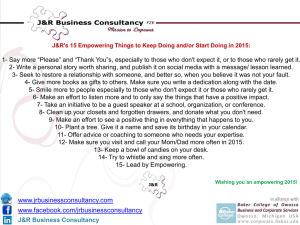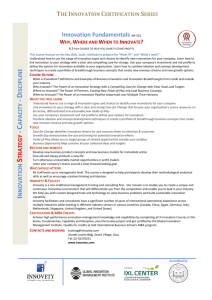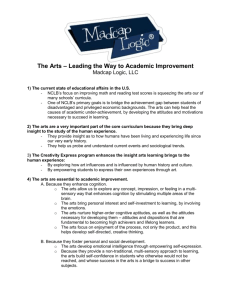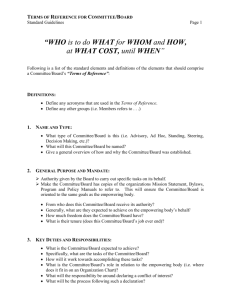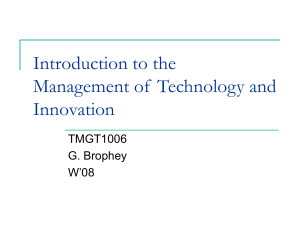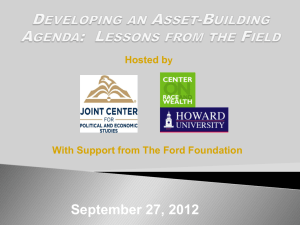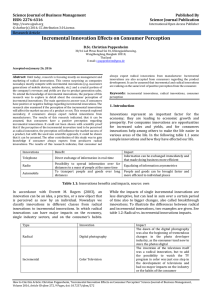Applying Innovation
advertisement
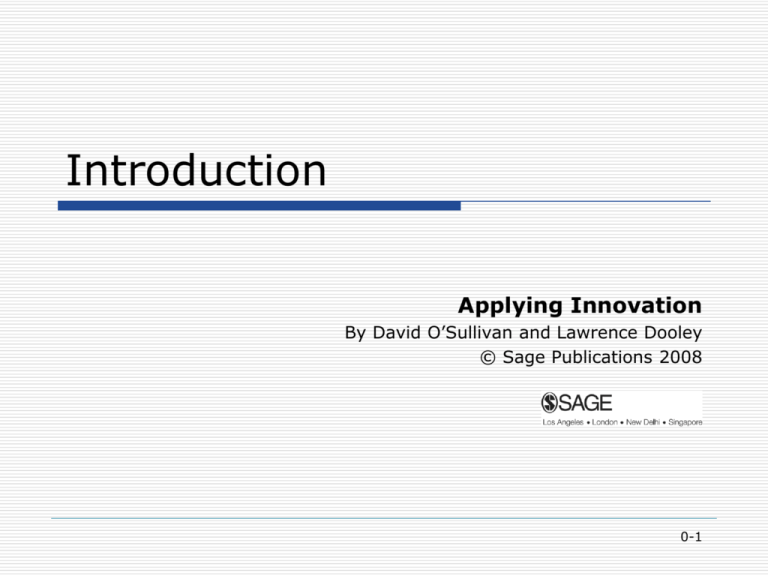
Introduction Applying Innovation By David O’Sullivan and Lawrence Dooley © Sage Publications 2008 0-1 Applying Innovation Innovation is an important force in creating and sustaining organizational growth. Effective innovation can mean the difference between leading with a particular product, process, or service and simply following the pack, with the resulting risk of stagnation and decline. Innovation transforms mediocre companies into world leaders and ordinary organizations into stimulating environments for employees. Innovation is the process of making changes to something established by introducing something new; these changes can be either radical or incremental. 0-2 Applying Innovation All organizations need to innovate, whether they are profit or nonprofit. Innovation is as relevant to services in a public hospital as it is for products and processes in a manufacturing company. Innovation takes place throughout an organization, from management boards and individual departments to project teams and individuals. In today’s global economy innovation is often a collaborative activity that takes place across extended organizations and includes suppliers, distributors, and other strategic alliances. 0-3 Aims Understanding key concepts in the theory and process of innovation Understanding how to manage and apply innovation Using explicit skills for defining goals, generating ideas, empowering teams, and monitoring the results of innovation Developing a simple knowledge management system for managing innovation Working effectively as an individual and as a member of a team Presenting, communicating, and promoting innovation plans Applying what you have learned to managing innovation in any organization 0-4 Symbiosis Applying Innovation is about describing how to systematically deliver innovations that add value to customers. The approach adopted is a symbiosis of management techniques that include: innovation management strategic planning performance measurement creativity project portfolio management performance appraisal knowledge management 0-5 Operate vs. Innovate How Organizations OPERATE ? versus How Organizations INNOVATE ? 0-6 Name some innovations! Products Processes Services Radical Incremental Long Life Short Life 0-7 Macintosh 0-8 PostIt 0-9 Ryanair 0-10 Pencil 0-11 Space Shuttle 0-12 iPhone 0-13 Wave bob 0-14 Toyota Prius 0-15 Charity Gift Cards A&E Processes African Water Pump Sensors Disruptive Innovation Name any innovations that dramatically disrupted or overturned an existing technology, product or service? 0-20 Background Innovation creates growth Growth Growth Growth Growth of of of of turnover and profits quality and productivity knowledge people Innovation also destroys Organisations that don’t innovate become obsolete Ideas that don’t satisfy customers are abandoned 0-21 Industry Trends “A new corporate model is taking shape focusing on creativity and innovation” “It isn’t just about math and science. It’s about creativity, imagination i.e. innovation.” 0-22 Structure Part Part Part Part Part I: Understanding Innovation II: Defining Innovation Goals III: Managing Innovation Actions IV: Empowering Innovation Teams V: Sharing Innovation Results 0-23 Part I: Understanding Innovation Develop an understanding for organizational innovation Explain the difference between product, process, and service innovation Understand radical and incremental innovation Understand the reasons why organizations invest in innovation Explain the main causes of failure in innovation Understand a process for managing innovation Describe the importance of the innovation funnel metaphor 0-24 Part II: Defining Innovation Goals Outline a process for defining innovation goals Use techniques for conducting environmental analysis Understand the importance of benchmarking in innovation Explain how to develop statements such as mission and vision statements Identify stakeholders and their requirements Describe the process of strategic planning Outline the process of creating performance indicators 0-25 Part III: Managing Innovation Actions Describe the creativity process Understand the various sources of ideas used in innovation Apply a number of idea generation tools Identify core aspects of project management Explain the product development process Understand how to capture critical data for innovation projects Explain the process of project portfolio management 0-26 Part IV: Empowering Innovation Teams Explain the importance of leadership in innovation Define the structure of innovation teams Understand how to build a team culture within the organization Describe some of the important attributes of virtual teams Understand communities of practice Explore various ways of increasing motivation Describe a simple performance appraisal system 0-27 Part V: Sharing Innovation Results Describe knowledge and how innovation knowledge can be managed Understand specific aspects of collaborative portals, portlets, and workspaces Discuss how to design and implement a simple knowledge management system Explain the relationships between different sets of innovation information Describe how organizations can contain a number of innovation communities Describe a hierarchy of innovation management processes or funnels Describe an approach to presenting and reporting a dynamic innovation plan 0-28 Innovation Funnel 0-29 Chapters 0-30 Programme Understanding Innovation 1. Defining Innovation 2. Managing Innovation 3. Processing Innovation Empowering Innovation Teams 11. Leading Innovation 12. Building Teams 13. Motivating Performance Defining Innovation Goals 4. Analyzing Environments 5. Defining Objectives 6. Measuring Indicators Sharing Innovation Results 14. Managing Knowledge 15. Building Communities 16. Extending Innovation Managing Innovation Actions 7. Creating Ideas 8. Managing Projects 9. Developing Products 10. Balancing Portfolios 0-31 Activities Activities in each chapter help you apply some of the ideas presented to your own organization Your organization can be real or fictitious and created from your imagination and experience Activities combine into one dynamic innovation plan for your organization Sample Innovation Plans available 0-32 SwitchIt Case SwitchIt Manufacturing in Ireland Subsidiary of SwitchIt U.S.A. Complete the case in Appendix! Individuals Name Andrew Kelly Breda Mooney Danny Mulryan David Noone Gary O'Halloran James Fogarty John Sheehan Mary Roche Michael Clark Stewart O'Neill David O'Sullivan Lawrence Dooley Job Title IT Analysist HR Manager General Manager Engineering Manager Training Manager Purchasing Manager Quality Coordinator Finance Controller Manufacturing Supervisor Materials Manager Design Manager Design Engineer 0-33 Reading ‘Applying Innovation’ O’Sullivan and Dooley Sage Publishing, 2009 Book Resources www.owl.ie 0-34

